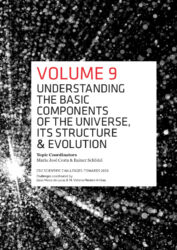Coordinación: María José Costa; Rainer Schödel
Fecha de publicación: 2021
Idioma: Inglés
Temática: Ciencia y Tecnología, Divulgación científica
Colección: CSIC Scientific Challenges : Towards 2030
Número de páginas: 121
ISBN: 978-84-00-10754-3
eISBN: 978-84-00-10755-0
Publicación: Madrid : Consejo Superior de Investigaciones Científicas, 2021
Referencia CSIC: 13677
Otros datos: (CSIC Scientific Challenges : Towards 2030 ; vol. 9)
Este es el volumen 9 de los 14 «Libros Blancos del CSIC» que definen su estrategia hasta 2030.
El libro contiene 10 retos. El reto 5 «FORMATION AND EVOLUTION OF GALAXIES AND LARGE STRUCTURES» ha sido coordinado por José Manuel Vílchez and J. Miguel Mas-Hesse (CAB), CSIC-INTA.
Otros investigadores del CAB que han participado en este reto son: Almudena Alonso-Herrero, Santiago Arribas, Miriam García, Jesús Maíz-Apellániz
El reto 6 «UNDERSTANDING THE CYCLE OF MATTER IN THE UNIVERSE» ha sido coordinado por Francisco Najarro (CAB), CSIC-INTA, and Javier R. Goicoechea
Otros investigadores del CAB que han participado en este reto son: Miriam García, Izaskun Jiménez-Serra, Ignacio Mendigutía, Carmen Sánchez-Contreras
Understanding the basic components of the Universe, its structure, and evolution is one of the noblest and most ambitious undertakings of humanity. The fundamental laws of nature are the basis of all technology. Finding and understanding them requires exploring both the elementary components of matter at the smallest scales and the observable Universe at the largest scales. Only through understanding the laws that dictated the first instances of the Universe will we be able to find the ultimate reason for its actual appearance and future fate. Challenges in physics are intimately associated with technological challenges for the design and building of telescopes, space missions or accelerators, reactor and underground experiments, as well as developments in mathematics. Their resolution requires a worldwide, transdisciplinary effort and the orchestrated involvement of researchers, engineers, and technicians. The challenges described here are fully aligned with the priorities identified in international and European strategies.







